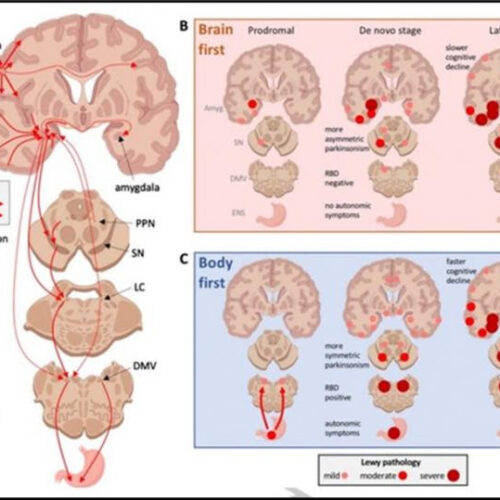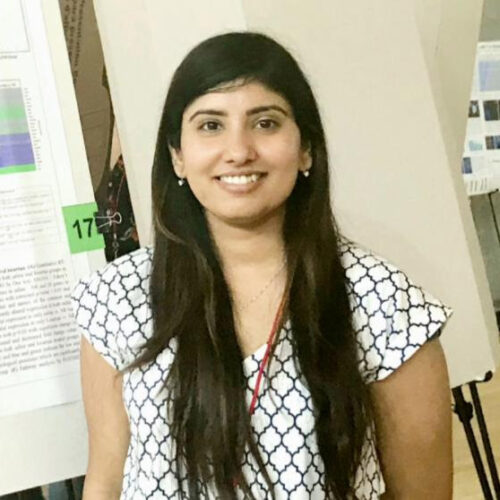UNIVERSITY OF COPENHAGEN – FACULTY OF SCIENCE Researchers from the University of Copenhagen, in collaboration with their Swiss colleagues at the University Hospital of Bern, have cracked the code for controlling a group of enzymes that affect our metabolism. The researchers’ findings could help us avoid diseases ranging from high cholesterol to infertility to certain types of...
New model may explain the mystery of asymmetry in Parkinson’s disease
IOS PRESS IMAGE: A) SCHEMATIC REPRESENTATION OF IMPORTANT CONNECTOME DETAILS IN PARKINSON’S DISEASE (PD). B) BRAIN-FIRST PD: THE ASYMMETRIC DISTRIBUTION OF ALPHA-SYNUCLEIN PERSISTS INTO LATER DISEASE STAGES. C) BODY-FIRST PD: THE SYMMETRIC ALPHA-SYNUCLEIN PATHOLOGY LEADS TO MORE SYMMETRIC MOTOR SYMPTOMS. CREDIT: JOURNAL OF PARKINSON’S DISEASE. Amsterdam, April 28, 2021 – Parkinson’s disease (PD) is characterized...
Treating neurological symptoms of CHARGE syndrome
by Institut national de la recherche scientifique – INRS SYNOPSIS: Loss‐of‐function of chd7 causes defects in GABAergic neuron development and behavioural anomalies reminiscent of CHARGE syndrome, which are rescued by genetic and pharmacological interventions in zebrafish. Credit: EMBO reports (2021). DOI: 10.15252/embr.202050958 CHARGE syndrome is a rare genetic disorder affecting about 1 in 10,000 newborns. It can...
RNA scientists identify many genes involved in neuron development
by University of Michigan Neurons in the fruit fly brain are made by passing through various differentiation states, and are segregated into unique subtypes based on the age and cell division number of their mother cell (progenitor). The complexity of this process is modelled in the diagram above. Different RNAs play a role in these neuron...
Scientists’ discovery of blood clotting mechanism could lead to new antithrombotic drugs
by Lehigh University Credit: CC0 Public Domain Under normal, healthy circulatory conditions, the von Willebrand Factor (vWF) keeps to itself. The large and mysterious glycoprotein moves through the blood, balled up tightly, its reaction sites unexposed. But when significant bleeding occurs, it springs into action, initiating the clotting process. When it works properly, vWF helps stop...
Eleven novel loci identified for rheumatoid arthritis
Eleven novel loci and 90 independent association signals have been identified for rheumatoid arthritis (RA), according to a study published in the May issue of the Annals of the Rheumatic Diseases. Eunji Ha, from Kyung Hee University in Seoul, South Korea, and colleagues conducted a meta-analysis of genome-wide RA association summary statistics in three large case-control...
New platform could help treat neurodegenerative diseases using regenerative medicine
Reviewed by Emily Henderson, B.Sc. Feb 24 2021 Imagine if surgeons could transplant healthy neurons into patients living with neurodegenerative diseases or brain and spinal cord injuries. And imagine if they could “grow” these neurons in the laboratory from a patient’s own cells using a synthetic, highly bioactive material that is suitable for 3D printing....
Using Light to Control Cells Holds Promise across the Body
By Simon Makin | Scientific American May 2021 Issue Credit: Getty Images Optogenetics is revolutionizing neuroscience. The technique involves genetically altering particular cell types to make them produce light-sensitive proteins; scientists can then activate the cells using light pulses delivered to the brain via fiber-optic cable. This has already given researchers an unparalleled ability to probe the circuitry underlying animal brain functions. But some...
Diabetes drug could protect against dangerous infection
EXPERIMENTAL BIOLOGY IMAGE: METFORMIN AND C. DIFFICILE CREDIT: SHAOHUA WANG, PHD, AND HARIOM YADAV, PHD Rockville, Md. (April 27, 2021)–Researchers from Wake Forest School of Medicine in North Carolina have demonstrated that a common diabetes drug inhibits the spread of Clostridioides difficile, or C. diff–a potentially life-threatening infection commonly acquired during hospital stays. The team will...
Potential advancements in treatment of PTSD and PTSD-related Cardiovascular disease
EXPERIMENTAL BIOLOGY IMAGE: LAXMI IYER, PHD, THE GEORGE WASHINGTON UNIVERSITY, WASHINGTON D.C. CREDIT: LAXMI IYER Rockville, Md. (April 27, 2021)–A new study reveals that renin-angiotensin system (RAS) genes within the amygdala–the brain region important for traumatic memory processing–express differently when the brain develops fearful memories, such as when people undergo traumatic stress. Researchers have found...








